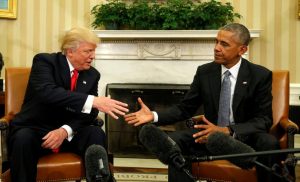(Akiit.com) What’s the difference between the $2 trillion “infrastructure” plan that Sen. Chuck Schumer, D-N.Y., and President Donald Trump have reportedly agreed to and then-President Barack Obama‘s so-called economic “stimulus”? Apart from the fact that the Schumer-Trump proposal is double the Obama price tag, the answer is: very little.
Economist Milton Friedman famously said there are four ways to spend money, from the most efficient to the least. The most efficient way is to spend your own money on yourself. That way, the money is spent exactly the way you choose and on exactly what you want. The second, less efficient way is to spend your money on someone else, such as when you are buying a gift; you’re somewhat careful about the cost and less careful about the content. The third, even less efficient way is to spend someone else’s money on yourself, as when you have a company expense account. You won’t be as careful spending company money as you are with your own, but you can’t go crazy without running the risk of being fired. Finally, the least efficient, most unproductive way is to spend someone else’s money on someone else.
Infrastructure spending falls into that least efficient category. Economist Steve Hanke writes: “In addition to cost overruns, the financing of infrastructure requires the imposition of taxes, and taxes impose costs beyond the amount of revenue raised. The excess burdens of taxation include ‘deadweight’ distortions and enforcement and compliance costs. In short, it costs more than a dollar to finance a dollar in government spending. The best estimates indicate that, on average, it costs between $1.50 to $1.60 to raise a dollar in tax revenue.
“Taking proper account of cost overruns and the costs of collecting taxes, one wonders if there are any public works projects that could justify federal financing, let alone financing to the tune of $1 trillion.”
Shortly after Obama’s presidential election, Vice President-elect Joe Biden said, “Every economist, as I’ve said, from conservative to liberal, acknowledges that direct government spending on a direct program now is the best way to infuse economic growth and create jobs.” This is not even remotely true.
In 2009, the libertarian Cato Institute took out full-page ads to criticize Obama’s “stimulus” plan. The ad was signed by more than 240 economists, including several Nobel Prize winners, with 130 more eventually endorsing the ad. It said:
“Notwithstanding reports that all economists are now Keynesians and that we all support a big increase in the burden of government, we the undersigned do not believe that more government spending is a way to improve economic performance. More government spending by Hoover and Roosevelt did not pull the United States economy out of the Great Depression in the 1930s. More government spending did not solve Japan’s ‘lost decade’ in the 1990s. As such, it is a triumph of hope over experience to believe that more government spending will help the U.S. today. To improve the economy, policymakers should focus on reforms that remove impediments to work, saving, investment and production. Lower tax rates and a reduction in the burden of government are the best ways of using fiscal policy to boost growth.”
The most famous domestic “stimulus” was the New Deal of President Franklin Roosevelt. University of Pennsylvania’s economist Harold L. Cole and UCLA’s economist Lee Ohanian argue that the New Deal extended the severe economic downturn of the Great Depression by seven years. Indeed, included in the diary of FDR’s Treasury Secretary Henry Morgenthau was a transcript of his May 9, 1939, meeting with his Treasury undersecretary and two members of the House Ways and Means Committee: “We have tried spending money. We are spending more than we have ever spent before and it does not work. … I want to see this country prosperous. I want to see people get a job. I want to see people get enough to eat. We have never made good on our promises. … I say after eight years of this Administration we have just as much unemployment as when we started. … And an enormous debt to boot!”
The common justification for this infrastructure spending is that it will address our “crumbling roads and bridges.” Even if that were true, under our system of federalism, why should taxpayers in one state help pay for roads and bridges in another state? And then there is the problem of “moral hazard.” Federal spending on local projects creates an incentive for states to spend money elsewhere knowing that the federal government stands ready to bail them out.
President Ronald Reagan needed no “stimulus” spending to jumpstart the economy. He reduced taxes and deregulated. In 2008, Senate Minority Leader Mitch McConnell slammed President-elect Obama’s proposed stimulus plan, calling it “nearly $10,000 in new debt for everyone who pays federal income tax, charged to the credit card for our children to pay — without safeguards, without appropriate hearings to scrutinize how tax dollars are being spent.”
He was right. What’s changed?
Columnist; Larry Elder
Official website; http://www.larryelder.com









Leave a Reply